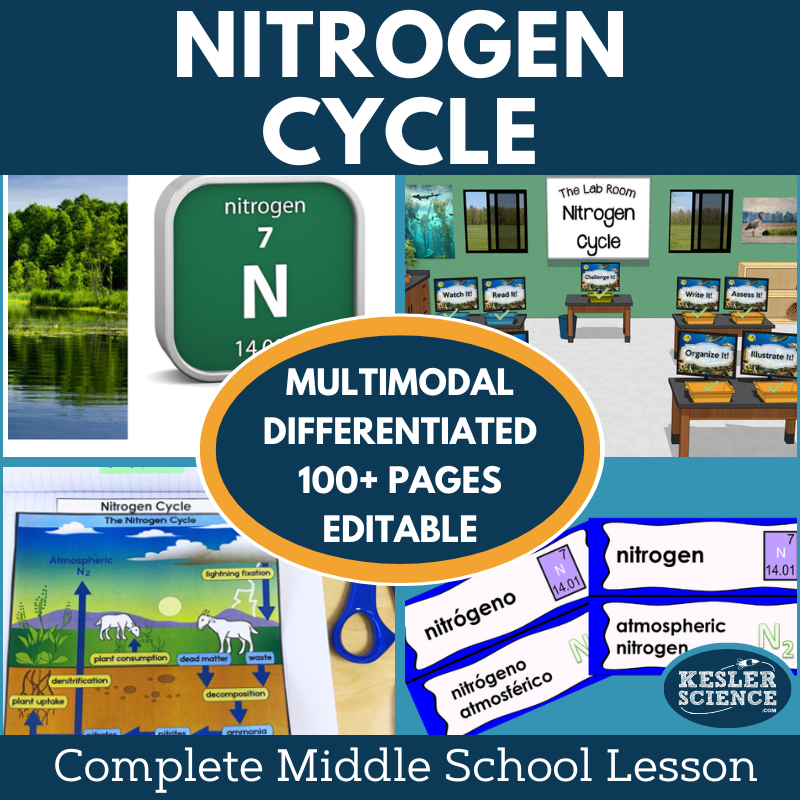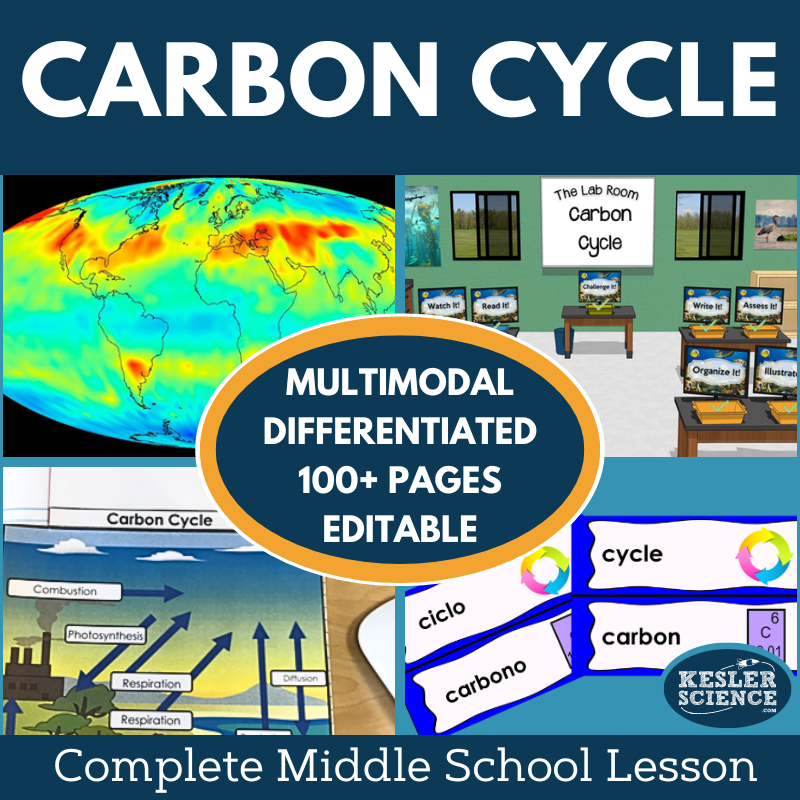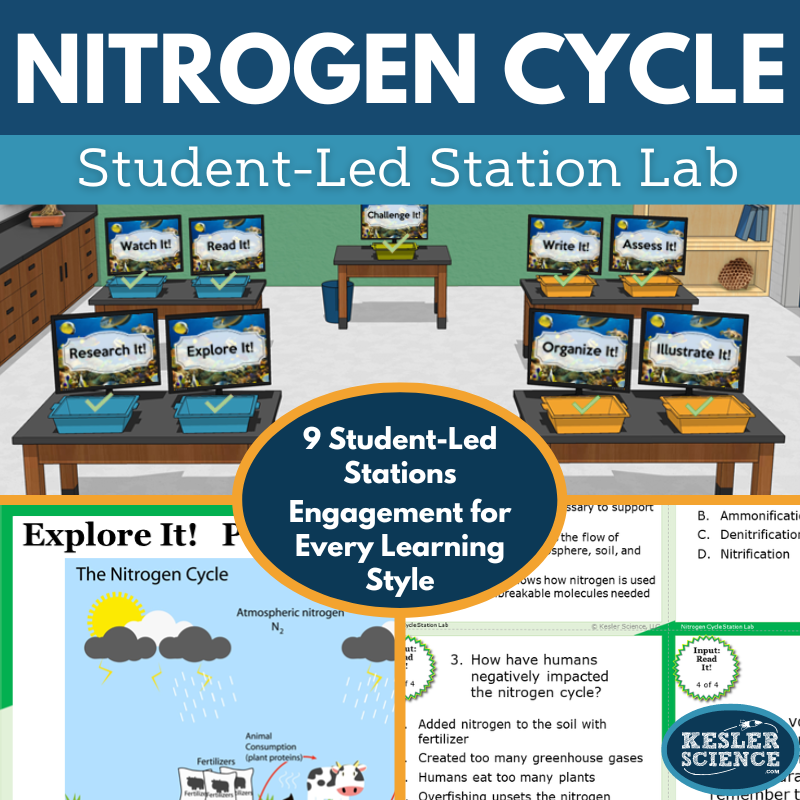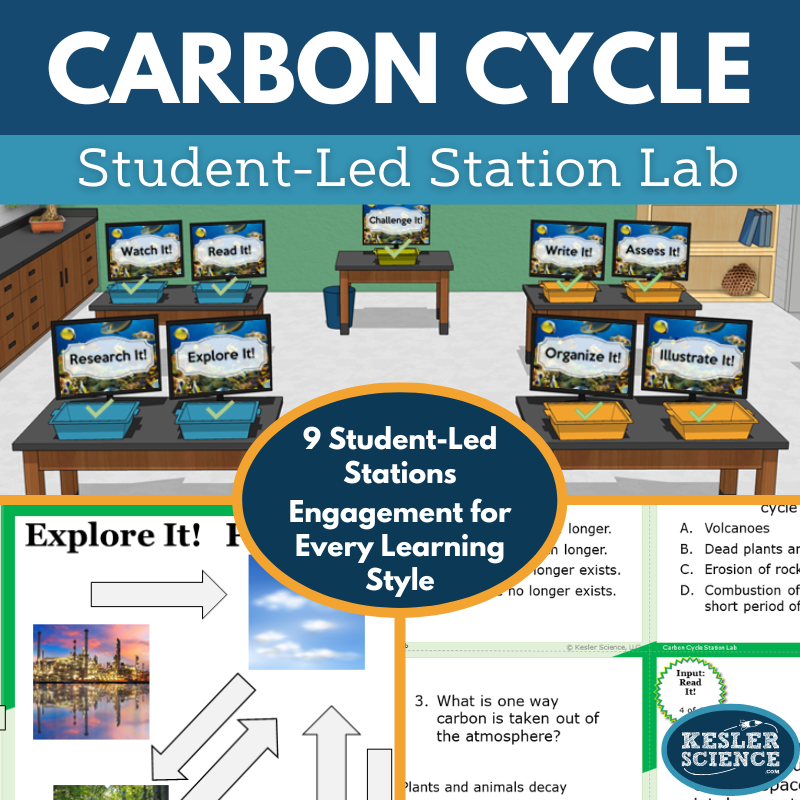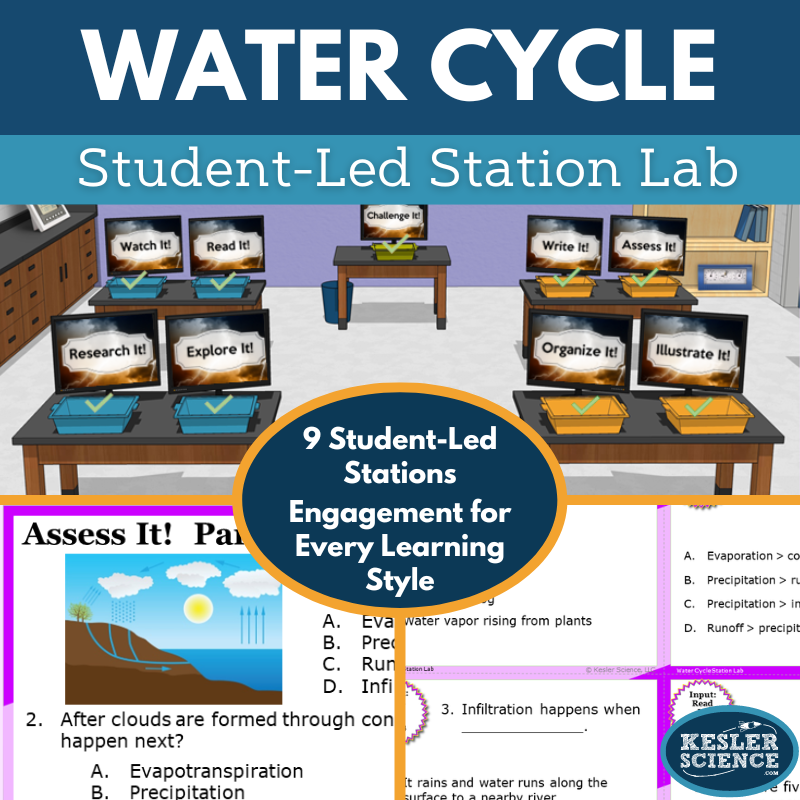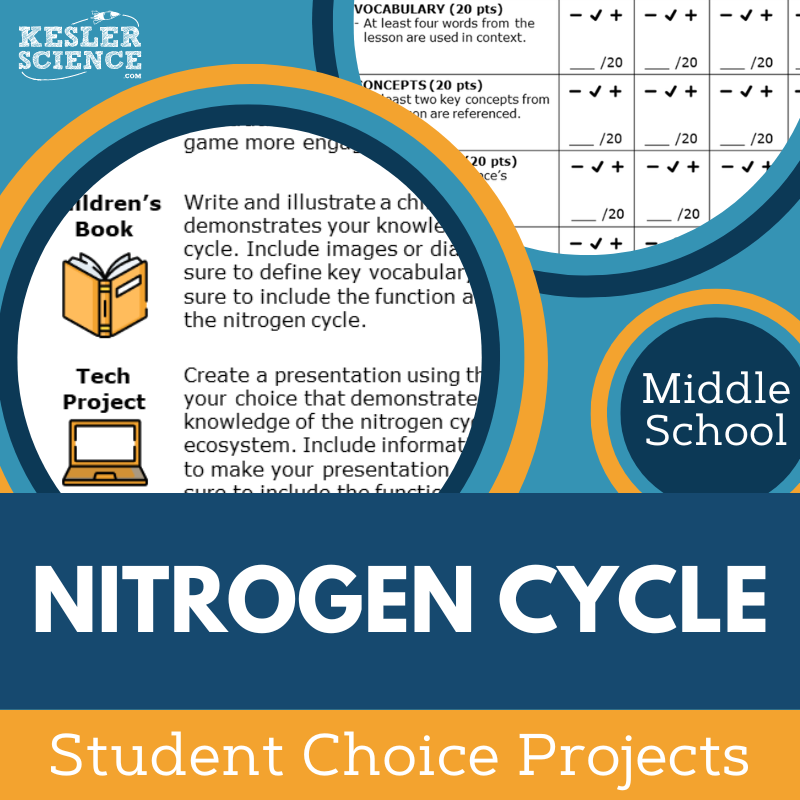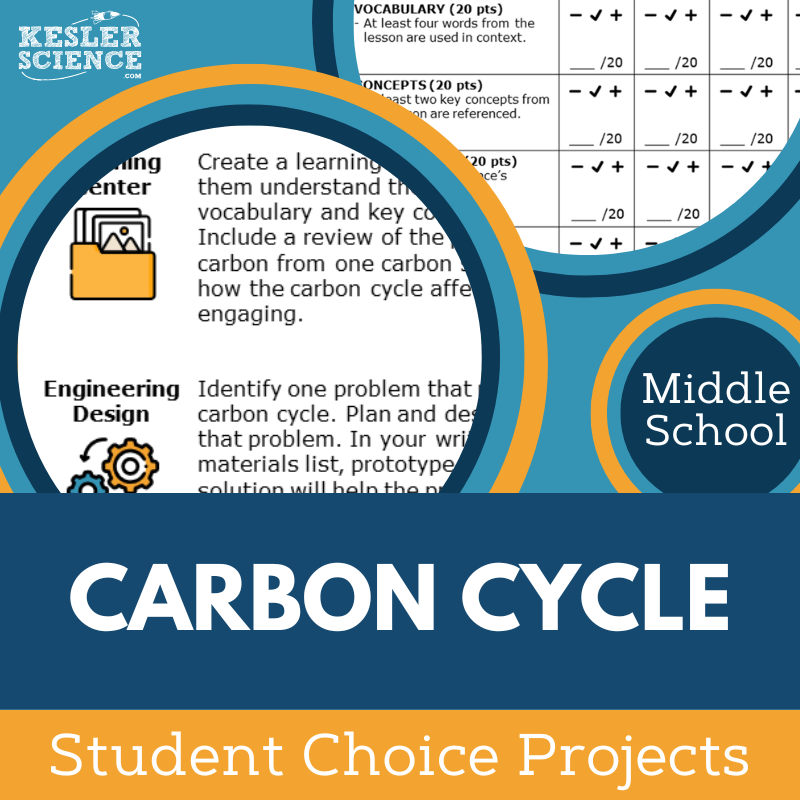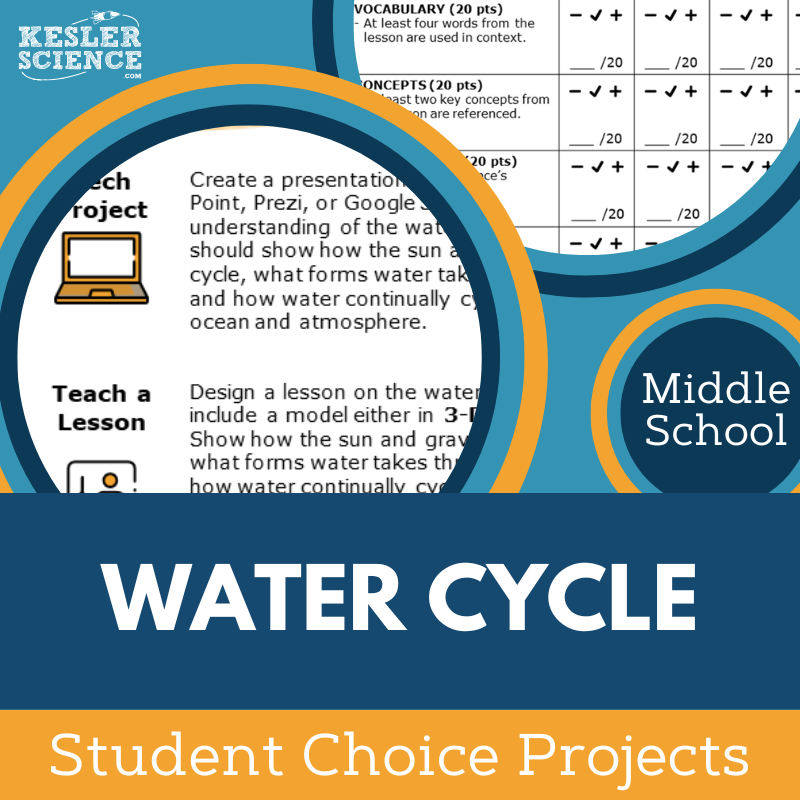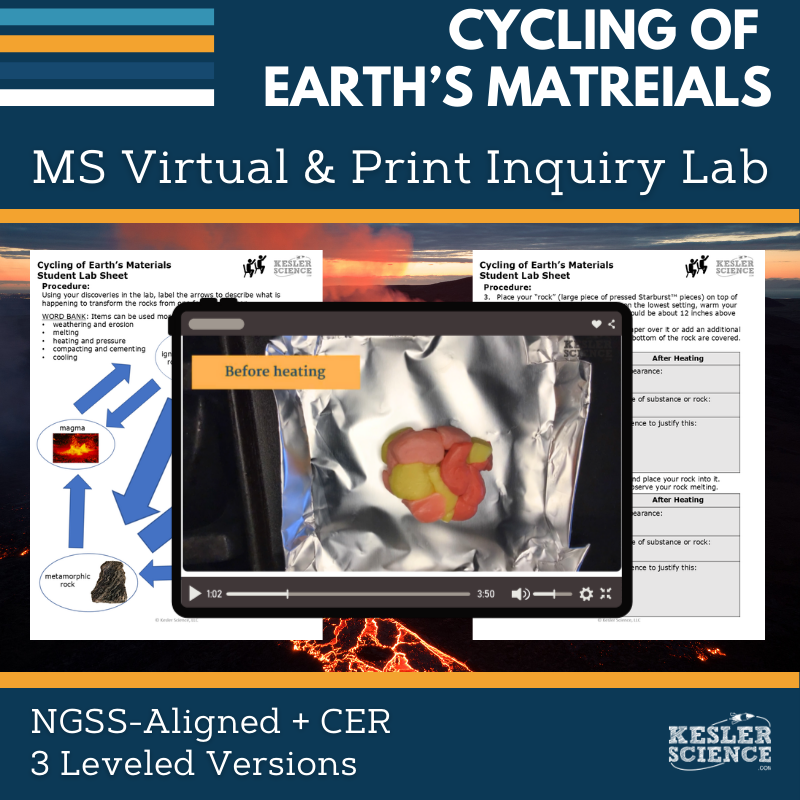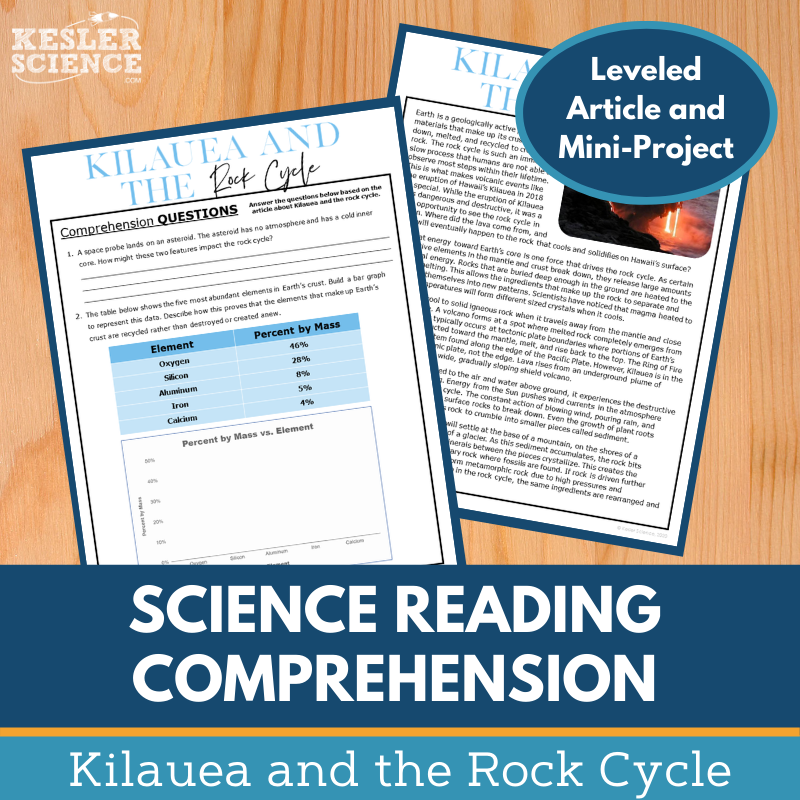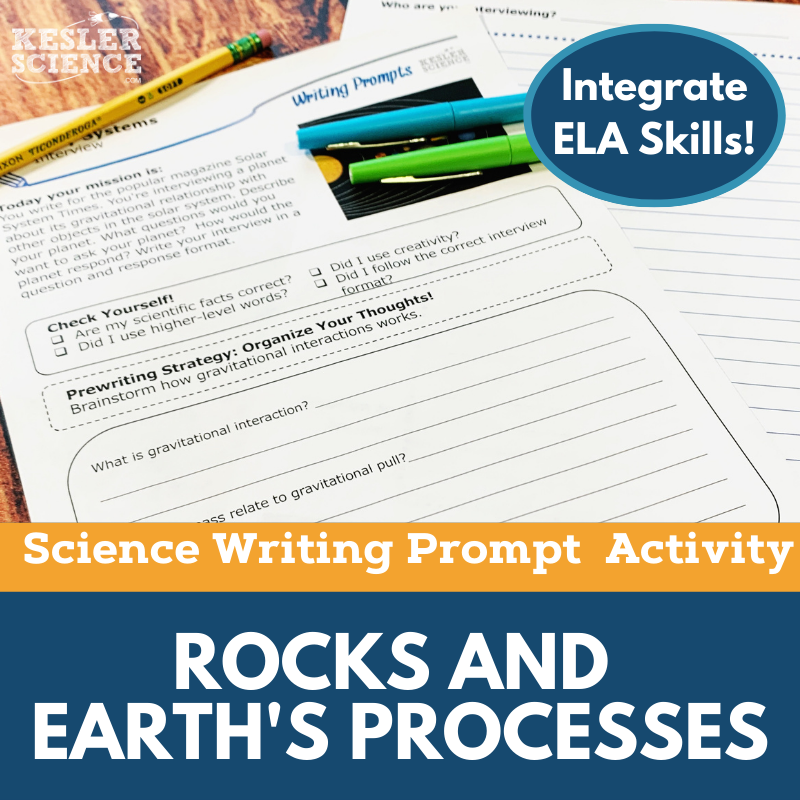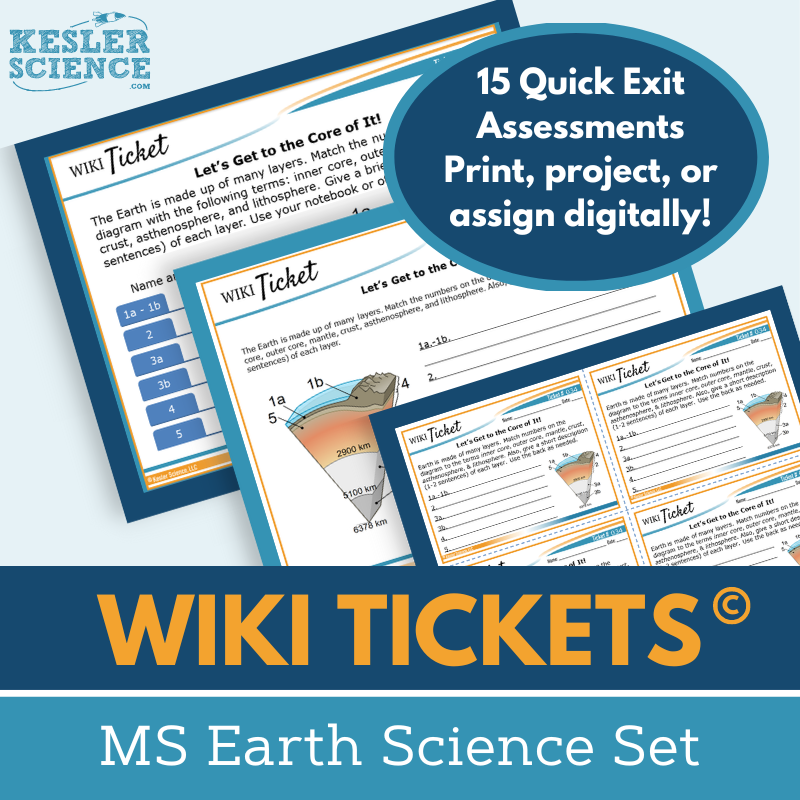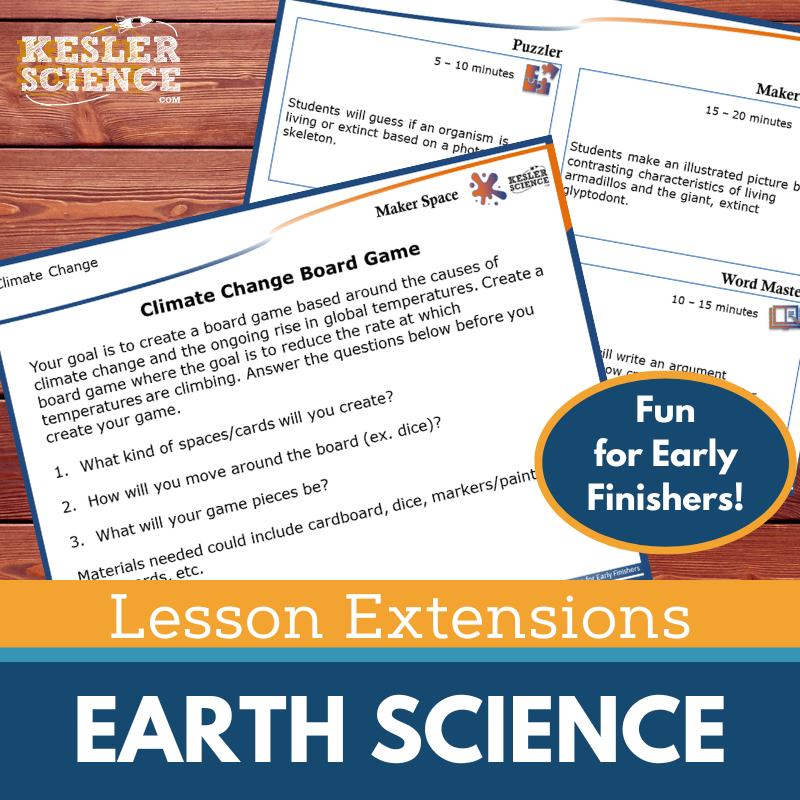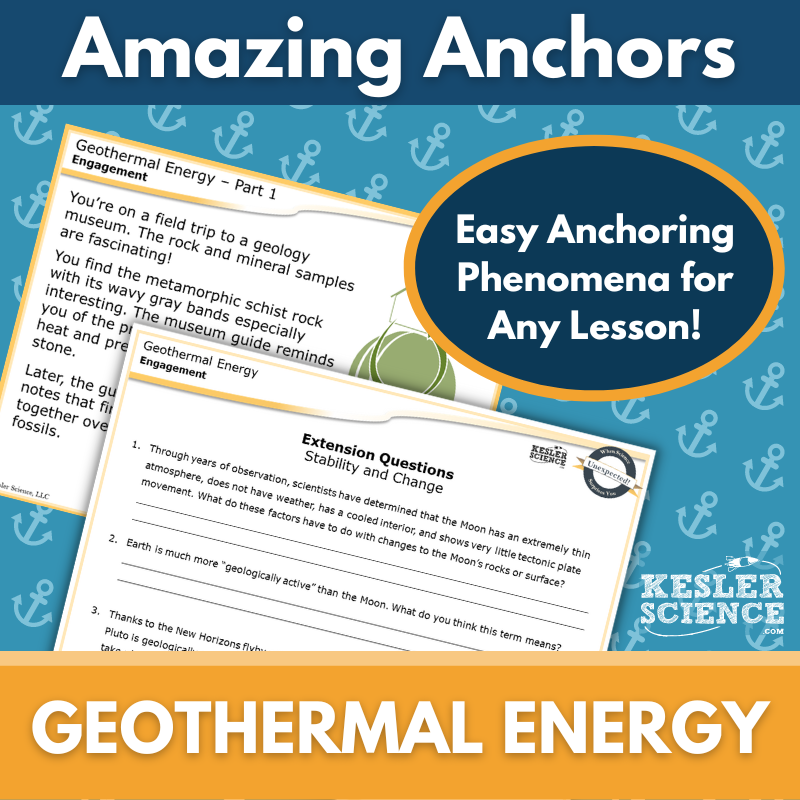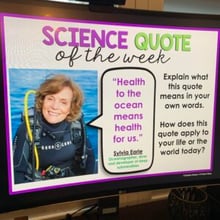Cycling of Earth's Materials Activities for Middle School Science
The Kesler Science Nitrogen, Carbon, and Water Cycle 5E Lessons engage students in exploring the movement of nitrogen and carbon through Earth's systems using a structured, student-led approach. The resources below will give students a comprehensive understanding of the cycling of Earth's materials. All of the following materials are also included in the Kesler Science Membership.
The Kesler Science Nitrogen Cycle 5E Lesson is a comprehensive, student-led unit exploring the processes of and human impact on the nitrogen cycle. It includes editable presentations, worksheets, choice projects, and assessments, designed for differentiated, multimodal learning with minimal prep. The lesson aligns with NGSS standards and is available in both printable and digital formats, with Spanish translations for key materials.
Following the 5E Model, the unit begins with engagement activities, including vocabulary word walls and discussion prompts. The exploration phase features a differentiated, nine-station lab with hands-on experiments, reading passages, research tasks, videos, and interactive exercises. Explanation resources include editable PowerPoints, interactive notebook templates, and guided note-taking tools. Students extend their learning through choice projects in the elaboration phase, while evaluation includes STAAR 2.0-aligned assessments, review worksheets, and modified testing options.
The lesson is fully adaptable for virtual learning, with digital resources available for both exploration and explanation. With its flexible, engaging approach, this unit ensures middle school students build a strong understanding of the nitrogen cycle while allowing teachers to focus on student success.
The Kesler Science Nitrogen Cycle 5E Lesson is a comprehensive, student-led unit exploring the processes of and human impact on the nitrogen cycle. It includes editable presentations, worksheets, choice projects, and assessments, designed for differentiated, multimodal learning with minimal prep. The lesson aligns with NGSS standards and is available in both printable and digital formats, with Spanish translations for key materials.
Following the 5E Model, the unit begins with engagement activities, including vocabulary word walls and discussion prompts. The exploration phase features a differentiated, nine-station lab with hands-on experiments, reading passages, research tasks, videos, and interactive exercises. Explanation resources include editable PowerPoints, interactive notebook templates, and guided note-taking tools. Students extend their learning through choice projects in the elaboration phase, while evaluation includes STAAR 2.0-aligned assessments, review worksheets, and modified testing options.
The lesson is fully adaptable for virtual learning, with digital resources available for both exploration and explanation. With its flexible, engaging approach, this unit ensures middle school students build a strong understanding of the nitrogen cycle while allowing teachers to focus on student success.
The Kesler Science Carbon Cycle 5E Lesson is a comprehensive, student-led unit designed for middle school. It includes presentations, worksheets, choice projects, and assessments, all fully editable and requiring minimal prep. The lesson follows the 5E Model, covering Engagement, Exploration, Explanation, Elaboration, and Evaluation, with differentiated and multimodal learning opportunities.
Students explore the carbon cycle through a station lab with nine hands-on, reading, research, and video-based stations. Activities include organizing information, writing responses, illustrating concepts, and answering assessment questions. Bonus stations provide additional challenges for early finishers. Editable PowerPoints, interactive notebook templates, and note-taking guides support explanation, while student-choice projects extend learning. Evaluation includes STAAR 2.0-aligned assessments, review questions, and worksheets.
With printable and digital formats, Spanish translations of key materials, and flexible implementation for in-person or virtual learning, this lesson engages students while supporting diverse learning needs.
The Kesler Science Carbon Cycle 5E Lesson is a comprehensive, student-led unit designed for middle school. It includes presentations, worksheets, choice projects, and assessments, all fully editable and requiring minimal prep. The lesson follows the 5E Model, covering Engagement, Exploration, Explanation, Elaboration, and Evaluation, with differentiated and multimodal learning opportunities.
Students explore the carbon cycle through a station lab with nine hands-on, reading, research, and video-based stations. Activities include organizing information, writing responses, illustrating concepts, and answering assessment questions. Bonus stations provide additional challenges for early finishers. Editable PowerPoints, interactive notebook templates, and note-taking guides support explanation, while student-choice projects extend learning. Evaluation includes STAAR 2.0-aligned assessments, review questions, and worksheets.
With printable and digital formats, Spanish translations of key materials, and flexible implementation for in-person or virtual learning, this lesson engages students while supporting diverse learning needs.
The Kesler Science Water Cycle 5E Lesson is a comprehensive middle school unit designed for engaging, student-led learning with minimal prep. It includes editable presentations, worksheets, choice projects, and assessments, all aligned with the 5E Model: Engagement, Exploration, Explanation, Elaboration, and Evaluation. The lesson supports differentiated instruction with multimodal learning and flexible formats, available in both digital and printable versions.
Students explore key concepts such as how water cycles through land, oceans, and the atmosphere, the role of the Sun and gravity, and the different forms water takes. A student-led station lab offers nine interactive stations, including hands-on experiments, reading comprehension, research tasks, video discussions, and creative activities. Editable PowerPoints, interactive notebooks, and note-taking templates support explanation, while student-choice projects extend learning. Evaluation includes STAAR 2.0-aligned assessments, review questions, and discussion worksheets.
Additional features include Spanish translations for vocabulary, reading passages, and interactive notebook pages. Designed for both in-person and virtual learning, this lesson provides a flexible, engaging approach to mastering the water cycle.
The Kesler Science Water Cycle 5E Lesson is a comprehensive middle school unit designed for engaging, student-led learning with minimal prep. It includes editable presentations, worksheets, choice projects, and assessments, all aligned with the 5E Model: Engagement, Exploration, Explanation, Elaboration, and Evaluation. The lesson supports differentiated instruction with multimodal learning and flexible formats, available in both digital and printable versions.
Students explore key concepts such as how water cycles through land, oceans, and the atmosphere, the role of the Sun and gravity, and the different forms water takes. A student-led station lab offers nine interactive stations, including hands-on experiments, reading comprehension, research tasks, video discussions, and creative activities. Editable PowerPoints, interactive notebooks, and note-taking templates support explanation, while student-choice projects extend learning. Evaluation includes STAAR 2.0-aligned assessments, review questions, and discussion worksheets.
Additional features include Spanish translations for vocabulary, reading passages, and interactive notebook pages. Designed for both in-person and virtual learning, this lesson provides a flexible, engaging approach to mastering the water cycle.
Engage your middle school students with this student-led nitrogen cycle station lab. Designed for independent or small-group learning, this interactive activity allows students to explore and compare key characteristics of the nitrogen cycle through nine differentiated stations.
Students engage with new concepts through hands-on demonstrations, research tasks, readings, and videos. They then demonstrate their understanding by organizing information, illustrating models, writing responses, and completing assessments. A bonus challenge station offers extension activities like crosswords, games, and mini-projects.
This modular, low-prep resource fosters student-driven learning and critical thinking and can be used in both in-person and virtual settings.
Engage your middle school students with this student-led nitrogen cycle station lab. Designed for independent or small-group learning, this interactive activity allows students to explore and compare key characteristics of the nitrogen cycle through nine differentiated stations.
Students engage with new concepts through hands-on demonstrations, research tasks, readings, and videos. They then demonstrate their understanding by organizing information, illustrating models, writing responses, and completing assessments. A bonus challenge station offers extension activities like crosswords, games, and mini-projects.
This modular, low-prep resource fosters student-driven learning and critical thinking and can be used in both in-person and virtual settings.
Engage your middle school students with this modular, student-led Carbon Cycle Station Lab. Designed for in-class or virtual learning, this interactive lesson helps students explore respiration, combustion, and decomposition through nine engaging stations featuring hands-on activities, research, reading, videos, and creative tasks.
Students independently or collaboratively complete tasks such as manipulating images, conducting research, answering questions, organizing information, illustrating models, and writing responses. A challenge station offers extension activities for early finishers. Differentiated reading passages in English and Spanish support diverse learners, and all necessary signage, resources, and task cards are included.
This low-prep, high-engagement resource promotes active learning and critical thinking, allowing teachers to facilitate rather than direct student learning.
Engage your middle school students with this modular, student-led Carbon Cycle Station Lab. Designed for in-class or virtual learning, this interactive lesson helps students explore respiration, combustion, and decomposition through nine engaging stations featuring hands-on activities, research, reading, videos, and creative tasks.
Students independently or collaboratively complete tasks such as manipulating images, conducting research, answering questions, organizing information, illustrating models, and writing responses. A challenge station offers extension activities for early finishers. Differentiated reading passages in English and Spanish support diverse learners, and all necessary signage, resources, and task cards are included.
This low-prep, high-engagement resource promotes active learning and critical thinking, allowing teachers to facilitate rather than direct student learning.
Engage your middle school students with this student-led Water Cycle Station Lab, designed to promote independent learning and critical thinking. This hands-on activity guides students in interpreting how water cycles through land, ocean, and atmosphere, identifying its various forms, and understanding the role of the Sun and gravity in the process.
Students explore these concepts through eight differentiated stations, each offering a unique approach to learning, plus a ninth challenge station for early finishers. Stations include hands-on experiments, research-based tasks, reading comprehension, video analysis, and interactive activities that encourage students to organize, illustrate, write about, and assess their understanding of the water cycle.
This modular resource includes all necessary signage, literature, task cards, and materials for independent or small-group learning, with both in-class and virtual options. English and Spanish reading passages support differentiated instruction, and digital versions allow students to manipulate images and text in PowerPoint or Google Slides.
This low-prep, high-engagement lesson fosters active participation and deeper comprehension of the water cycle.
Engage your middle school students with this student-led Water Cycle Station Lab, designed to promote independent learning and critical thinking. This hands-on activity guides students in interpreting how water cycles through land, ocean, and atmosphere, identifying its various forms, and understanding the role of the sun and gravity in the process.
Students explore these concepts through eight differentiated stations, each offering a unique approach to learning, plus a ninth challenge station for early finishers. Stations include hands-on experiments, research-based tasks, reading comprehension, video analysis, and interactive activities that encourage students to organize, illustrate, write about, and assess their understanding of the water cycle.
This modular resource includes all necessary signage, literature, task cards, and materials for independent or small-group learning, with both in-class and virtual options. English and Spanish reading passages support differentiated instruction, and digital versions allow students to manipulate images and text in PowerPoint or Google Slides.
This low-prep, high-engagement lesson fosters active participation and deeper comprehension of the water cycle.
The Nitrogen Cycle Student Choice Projects lesson aligns with NGSS science standards, allowing middle school students to select a project that fits their preferred learning style. A project page outlines six student-led options plus a “design your own” project, all supported by an editable rubric for teacher, peer, or self-assessment.
These flexible, multimodal projects provide creative ways for students to demonstrate their understanding. Two versions of the project page support differentiation, with modified options for students needing remediation and challenge opportunities for advanced learners. Teachers can adjust the rubric to fit their grading needs.
The projects require standard classroom supplies like paper, markers, and scissors, with many options available for digital completion. Some crafting materials may be helpful for model-building activities.
The Nitrogen Cycle Student Choice Projects lesson aligns with NGSS science standards, allowing middle school students to select a project that fits their preferred learning style. A project page outlines six student-led options plus a “design your own” project, all supported by an editable rubric for teacher, peer, or self-assessment.
These flexible, multimodal projects provide creative ways for students to demonstrate their understanding. Two versions of the project page support differentiation, with modified options for students needing remediation and challenge opportunities for advanced learners. Teachers can adjust the rubric to fit their grading needs.
The projects require standard classroom supplies like paper, markers, and scissors, with many options available for digital completion. Some crafting materials may be helpful for model-building activities.
The Carbon Cycle Student Choice Projects lesson allows middle school students to select a project that matches their preferred output style. A project page outlines six student-led options plus a “design your own” project, with a rubric for teacher, peer, or self-assessment.
These flexible, multimodal projects provide creative ways for students to demonstrate their understanding. Teachers can modify the rubric to fit their grading needs. Two versions of the project page support differentiation, with modified options for students needing remediation and challenge options for advanced learners.
Projects use standard classroom supplies like paper, markers, and scissors, with many options available for digital completion. Some crafting supplies may be helpful for model-building.
The Carbon Cycle Student Choice Projects lesson allows middle school students to select a project that matches their preferred output style. A project page outlines six student-led options plus a “design your own” project, with a rubric for teacher, peer, or self-assessment.
These flexible, multimodal projects provide creative ways for students to demonstrate their understanding. Teachers can modify the rubric to fit their grading needs. Two versions of the project page support differentiation, with modified options for students needing remediation and challenge options for advanced learners.
Projects use standard classroom supplies like paper, markers, and scissors, with many options available for digital completion. Some crafting supplies may be helpful for model-building.
The Water Cycle Student Choice Projects lesson aligns with NGSS standards, allowing middle school students to choose a project that fits their preferred output style. A project page outlines six student-led options plus a “design your own” project, with an editable rubric for teacher, peer, or self-assessment.
These flexible, multimodal projects provide creative ways for students to demonstrate their understanding. Two versions of the project page support differentiation, with modified options for students needing remediation and challenge opportunities for advanced learners. Teachers can adjust the rubric to fit grading needs.
The projects use standard classroom supplies like paper, markers, and scissors, and many options are available for digital completion.
The Water Cycle Student Choice Projects lesson aligns with NGSS standards, allowing middle school students to choose a project that fits their preferred output style. A project page outlines six student-led options plus a “design your own” project, with an editable rubric for teacher, peer, or self-assessment.
These flexible, multimodal projects provide creative ways for students to demonstrate their understanding. Two versions of the project page support differentiation, with modified options for students needing remediation and challenge opportunities for advanced learners. Teachers can adjust the rubric to fit grading needs.
The projects use standard classroom supplies like paper, markers, and scissors, and many options are available for digital completion.
The Cycling of Earth's Materials Inquiry Lab aligns with NGSS MS-ESS2-1, helping students develop a model to describe the cycling of Earth's materials and the energy flow driving this process. This lab offers both hands-on and virtual formats, allowing flexibility for different learning environments.
Students will explore how rocks are classified and the processes that move them through the rock cycle. The lab includes comprehension questions, Claim-Evidence-Reasoning (C.E.R.) prompts, and a reflection section. Three differentiated versions—dependent, modified, and independent—ensure accessibility for all learners.
The print format provides an in-person laboratory experience where students manipulate Starburst candies to model rock transformations using tools like scissors, hot plates, and blow dryers. Each student completes their own lab sheet. The digital version, compatible with Google Slides, MS Teams, and other platforms, includes an interactive PowerPoint with a pre-recorded video demonstrating the lab procedure, making it accessible for absent students or those without materials.
Kesler Science resources offer editable PowerPoints, multimodal learning opportunities, and detailed teacher support, including answer keys, CER statements, and differentiated materials. Both formats ensure an engaging and flexible learning experience for middle school students.
The Cycling of Earth's Materials Inquiry Lab aligns with NGSS MS-ESS2-1, helping students develop a model to describe the cycling of Earth's materials and the energy flow driving this process. This lab offers both hands-on and virtual formats, allowing flexibility for different learning environments.
Students will explore how rocks are classified and the processes that move them through the rock cycle. The lab includes comprehension questions, Claim-Evidence-Reasoning (C.E.R.) prompts, and a reflection section. Three differentiated versions—dependent, modified, and independent—ensure accessibility for all learners.
The print format provides an in-person laboratory experience where students manipulate Starburst candies to model rock transformations using tools like scissors, hot plates, and blow dryers. Each student completes their own lab sheet. The digital version, compatible with Google Slides, MS Teams, and other platforms, includes an interactive PowerPoint with a pre-recorded video demonstrating the lab procedure, making it accessible for absent students or those without materials.
Kesler Science resources offer editable PowerPoints, multimodal learning opportunities, and detailed teacher support, including answer keys, CER statements, and differentiated materials. Both formats ensure an engaging and flexible learning experience for middle school students.
The Rock Cycle Escape Room is an interactive activity that allows students to demonstrate their understanding of the rock cycle, including igneous, sedimentary, and metamorphic rocks, as well as key processes like weathering, erosion, compaction, cementation, heat and pressure, and cooling.
Teachers have full control over the eight independent puzzles, selecting which to use and in what order, making it adaptable for different class lengths. The activity can be run using manila envelopes for a simple setup or with locks and a storage box for a more immersive experience. Both methods require printed materials and envelopes.
For digital learning, students can use the Single Student Digital Version, available as a PowerPoint or Google Slides file, which allows them to solve puzzles by answering questions and manipulating images. A printable version in PPT or PDF is also available for at-home learning.
The resource includes teacher directions, detailed answer keys, an editable version, a digital answer sheet via Google Forms, a video challenge, printable props, reward templates, and over 50 prize ideas. With engaging puzzles and interactive challenges, this escape room will leave students excited about learning the rock cycle.
The Rock Cycle Escape Room is an interactive activity that allows students to demonstrate their understanding of the rock cycle, including igneous, sedimentary, and metamorphic rocks, as well as key processes like weathering, erosion, compaction, cementation, heat and pressure, and cooling.
Teachers have full control over the eight independent puzzles, selecting which to use and in what order, making it adaptable for different class lengths. The activity can be run using manila envelopes for a simple setup or with locks and a storage box for a more immersive experience. Both methods require printed materials and envelopes.
For digital learning, students can use the Single Student Digital Version, available as a PowerPoint or Google Slides file, which allows them to solve puzzles by answering questions and manipulating images. A printable version in PPT or PDF is also available for at-home learning.
The resource includes teacher directions, detailed answer keys, an editable version, a digital answer sheet via Google Forms, a video challenge, printable props, reward templates, and over 50 prize ideas. With engaging puzzles and interactive challenges, this escape room will leave students excited about learning the rock cycle.
This Earth’s Systems Science Reading Comprehension Lesson engages students with a nonfiction article about Kilauea and the rock cycle. Designed for middle school, the passage supports science literacy and reading comprehension through leveled reading, comprehension questions, and a hands-on mini-project.
Students will complete five to seven comprehension questions and create a labeled diagram that models the cycling of Earth's materials and the flow of energy. A Cornell notes template is included for additional support.
Perfect for sub plans, extra credit, ISS, or whole-class instruction, this resource fosters critical thinking, classroom discussions, and textual analysis. It is compatible with both in-person and virtual learning environments, including Google Classroom, MS Teams, Schoology, and Canvas.
This Earth’s Systems Science Reading Comprehension Lesson engages students with a nonfiction article about Kilauea and the rock cycle. Designed for middle school, the passage supports science literacy and reading comprehension through leveled reading, comprehension questions, and a hands-on mini-project.
Students will complete five to seven comprehension questions and create a labeled diagram that models the cycling of Earth's materials and the flow of energy. A Cornell notes template is included for additional support.
Perfect for sub plans, extra credit, ISS, or whole-class instruction, this resource fosters critical thinking, classroom discussions, and textual analysis. It is compatible with both in-person and virtual learning environments, including Google Classroom, MS Teams, Schoology, and Canvas.
The Rocks and Earth Processes Science Writing Prompt Activity engages middle school students in a creative skit or drama-based exercise to test their knowledge of earth science. Aligned with NGSS MS-ESS2-1, this activity encourages science reasoning, exploration, and writing skills while supporting both in-person and virtual learning.
This resource includes teacher directions with an answer guide, project ideas, and rubrics, along with projection and print handouts in both full and half-sheet formats. A digital interactive PowerPoint version is also available, which can be used in Google Slides for remote or in-person learning. Designed for cross-curricular use, pre-test assessments, student choice projects, early finisher activities, extra credit, make-up work, TELPAS samples, or differentiation exercises, this writing prompt fosters engagement and creativity. Students’ work can be displayed on bulletin boards or compiled into anthologies, making it a valuable addition to any science classroom.
The Rocks and Earth Processes Science Writing Prompt Activity engages middle school students in a creative skit or drama-based exercise to test their knowledge of earth science. Aligned with NGSS MS-ESS2-1, this activity encourages science reasoning, exploration, and writing skills while supporting both in-person and virtual learning.
This resource includes teacher directions with an answer guide, project ideas, and rubrics, along with projection and print handouts in both full and half-sheet formats. A digital interactive PowerPoint version is also available, which can be used in Google Slides for remote or in-person learning. Designed for cross-curricular use, pre-test assessments, student choice projects, early finisher activities, extra credit, make-up work, TELPAS samples, or differentiation exercises, this writing prompt fosters engagement and creativity. Students’ work can be displayed on bulletin boards or compiled into anthologies, making it a valuable addition to any science classroom.
The WIKI Tickets© Earth Science Set provides engaging, flexible formative assessments for 6th-8th grade science. This set includes 15 topics, each available in five formats: a full-screen projection version, three printable handout options, and an interactive digital version compatible with PowerPoint and Google Slides.
Aligned with NGSS and TEKS standards, these assessments cover key Earth Science topics, including ecoregions in Texas, human impact on the environment and natural resources, land and erosion features, Earth's layers, tectonic plates, minerals, the rock cycle, and watersheds. Each standard has at least one corresponding ticket, with some topics having multiple assessments. A bonus table of contents file provides alignment details.
Designed for both in-person and virtual learning, WIKI Tickets© can be used as exit tickets, bellringers, or quick comprehension checks. Students can respond on printed handouts, their own paper, or digitally in a 1:1 or remote setting. These colorful assessments help you gauge student understanding with ease.
The WIKI Tickets© Earth Science Set provides engaging, flexible formative assessments for 6th-8th grade science. This set includes 15 topics, each available in five formats: a full-screen projection version, three printable handout options, and an interactive digital version compatible with PowerPoint and Google Slides.
Aligned with NGSS and TEKS standards, these assessments cover key Earth Science topics, including ecoregions in Texas, human impact on the environment and natural resources, land and erosion features, Earth's layers, tectonic plates, minerals, the rock cycle, and watersheds. Each standard has at least one corresponding ticket, with some topics having multiple assessments. A bonus table of contents file provides alignment details.
Designed for both in-person and virtual learning, WIKI Tickets© can be used as exit tickets, bellringers, or quick comprehension checks. Students can respond on printed handouts, their own paper, or digitally in a 1:1 or remote setting. These colorful assessments help you gauge student understanding with ease.
Lesson Extensions provide engaging, student-choice activities designed to challenge early finishers with critical thinking and creativity. They help reinforce learning, fill downtime during testing, and keep students focused with rigorous yet enjoyable activities aligned to NGSS and TEKS earth science standards.
Each extension includes four interactive components: Puzzler for problem-solving, Maker Space for hands-on STEAM activities, Tech Connection for digital demonstrations, and Word Master for creative writing. With teacher directions, answer keys, and both print and projection versions, these extensions are perfect for lesson wrap-ups, enrichment, or independent challenges.
Topics covered include circulation and climate, climate change, Earth's changing surface, tectonic plates, rock formation, fossil records, and more. These extensions provide high-level, engaging materials that deepen students' understanding of earth science concepts.
Lesson Extensions provide engaging, student-choice activities designed to challenge early finishers with critical thinking and creativity. They help reinforce learning, fill downtime during testing, and keep students focused with rigorous yet enjoyable activities aligned to NGSS and TEKS earth science standards.
Each extension includes four interactive components: Puzzler for problem-solving, Maker Space for hands-on STEAM activities, Tech Connection for digital demonstrations, and Word Master for creative writing. With teacher directions, answer keys, and both print and projection versions, these extensions are perfect for lesson wrap-ups, enrichment, or independent challenges.
Topics covered include circulation and climate, climate change, Earth's changing surface, tectonic plates, rock formation, fossil records, and more. These extensions provide high-level, engaging materials that deepen students' understanding of earth science concepts.
This NGSS-aligned Amazing Anchors Phenomenon Lesson introduces the cycling of energy and matter in the Earth through a real-world context. It begins with an introductory reading about a field trip to a geology museum, accompanied by comprehension and extension questions to prepare students for deeper learning. An explanatory reading then breaks down the science behind geothermal heating, with additional comprehension and reinforcement questions to solidify understanding.
This no-prep resource includes teacher directions with answer keys, full-page projection slides, editable digital PowerPoint files for LMS platforms, and printable handouts in full- and half-sheet formats. Designed to complement any science lesson, it aligns with NGSS standard ESS2-1 and fits seamlessly into the Engagement and Elaborate segments of the 5E model. A differentiated version supports students with modified language and sentence starters. Available in both print and digital formats, this lesson is a flexible tool for in-person or distance learning.
This NGSS-aligned Amazing Anchors Phenomenon Lesson introduces the cycling of energy and matter in the Earth through a real-world context. It begins with an introductory reading about a field trip to a geology museum, accompanied by comprehension and extension questions to prepare students for deeper learning. An explanatory reading then breaks down the science behind geothermal heating, with additional comprehension and reinforcement questions to solidify understanding.
This no-prep resource includes teacher directions with answer keys, full-page projection slides, editable digital PowerPoint files for LMS platforms, and printable handouts in full- and half-sheet formats. Designed to complement any science lesson, it aligns with NGSS standard ESS2-1 and fits seamlessly into the Engagement and Elaborate segments of the 5E model. A differentiated version supports students with modified language and sentence starters. Available in both print and digital formats, this lesson is a flexible tool for in-person or distance learning.
Year-Round Resources
These year-round activities will increase your students' understanding of many middle school science topics. All of these activities are also included in the Kesler Science Membership.
Visual Data & Graphing
You're not alone if your students struggle with understanding graphs, charts, and tables. It's a skill that takes an enormous amount of practice. This resource will help students build a strong foundation in analyzing data and creating their own data visualizations.
Bell Ringers and Warm-Ups
These middle school science bell ringers are an excellent way to engage your students as soon as they walk into your classroom. This comprehensive FULL YEAR resource includes everything you need to start off each science class with an interesting warm-up activity.
Review Board Games
Each game board has been carefully designed to keep students engaged. There are 10 different action spaces on each board and dozens of question cards. All of the actions are related to science concepts and keep the students motivated throughout the game.
Each game is ready to play. Simply print out the board and the cards and let the students enjoy reviewing nine different units.
Essential Questions and Standards
Below are the essential questions and standards associated with the lessons and activities included in the cycling of Earth's materials unit. This topic is only one of more than 100 middle school science topics included in the Kesler Science Membership.
-
What is the nitrogen cycle?
-
What processes are involved in the nitrogen cycle?
-
How do humans alter/impact the nitrogen cycle?
-
How do microhabitats and biomes support different varieties of organisms?
-
How does water continually cycle among land, oceans, and atmosphere?
-
What forms does water take through this cycle?
-
How is the water cycle affected by the Sun and gravity?
-
NGSS - MS-ESS2-1 Cycling of Earth's Materials
Kesler Science Membership
Imagine never having to search for another middle school science lesson again. The membership gives you access to ALL of the Kesler Science products in one place (Yes, including everything above).
Say goodbye to long hours of lesson prep.

